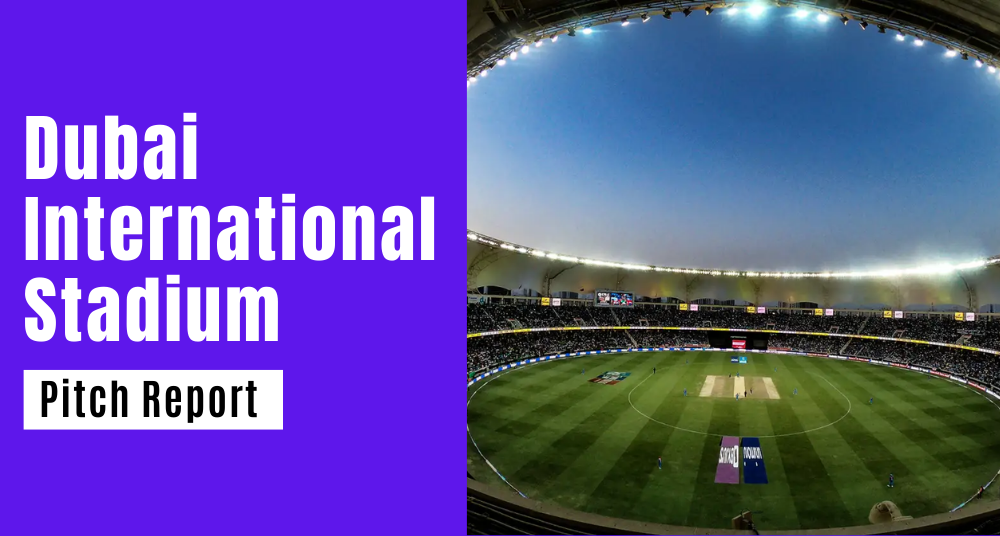Nestled in the heart of Dubai Sports City, the Dubai International Cricket Stadium has quickly become a cornerstone of global limited-overs cricket. Its reputation as a neutral yet high-stakes venue—host to qualifiers, Champions Trophy matches, and now the 2025 Asia Cup—makes its pitch dynamics a subject of fascination for players, analysts, and fans alike. In this Dubai international stadium pitch report, we explore the surface characteristics, strategic implications, and forecast how upcoming fixtures could tip the scales.
Understanding the Dubai cricket stadium pitch report is essential: it reveals trends in seam, spin, batting tempo, dew influence, and toss strategies. Whether you’re plotting fantasy picks, commentary insights, or team tactics, a well-informed Dubai pitch report is your insider’s guide to mastering this multifaceted surface.
Stadium Overview & Ground Context
The Dubai International Cricket Stadium—also known as the Ring of Fire due to its iconic floodlight structure—boasts a seating capacity of over 25,000, modern player amenities, and a cricket field with balanced dimensions. It forms a key part of UAE cricket infrastructure, often selected for high-profile matches when geopolitical factors mandate neutral venues.
The pitch here is generally consistent: hard and flat, with early assistance to seamers and increasing help for spinners as the game progresses. Lighting conditions under the “Ring of Fire” shine down late into the match, affecting dew and ball behavior significantly.
- Full Name: Dubai International Stadium
- Former names: Dubai Sports City Cricket Stadium
- Location: Prime Business Centre, Sheikh Mohammed Bin Zayed Rd, Jumeirah Village, Dubai Sports City, Dubai,United Arab Emirates
- Operator: Dubai sports city
- Seating Capacity: 25,000
- Field size: 148 Mtr x 130 Mtr
- Surface: Grass
- Floodlights: Yes
- End names: Emirates Road End , Dubai Sports City End
- Home team: Dubai Capitals
- Construction Architect (Contractor): Awsam Matloob
- Boundary Length (Dimension): 161 Yd x 142 Yd
- Also known as: Dubai Sports City (DSC) Cricket Stadium
Dubai International Cricket Stadium Ground Dimensions
The Dubai Pitch Report gives a clear picture of how the ground dimensions influence batting and bowling strategies. At the Dubai International Cricket Stadium, the boundaries vary in size depending on the direction, making shot selection crucial for batters and field placement important for bowlers. Typically, the straight boundaries are longer compared to the square boundaries, which often encourages batsmen to play more wristy or square shots.
Here are the approximate boundary lengths of the stadium:
- Leg Side Boundary Length: 61 meters
- Off Side Boundary Length: 69 meters
- Straight Boundary Length: 83 meters
- Back Side Boundary Length: 65 meters
These boundary measurements, combined with the pitch conditions, significantly impact match outcomes. The dubai international cricket stadium pitch report often highlights that the surface here is balanced, offering assistance to both batters and bowlers depending on weather, dew factor, and match format (T20, ODI, or Test).
Dubai Stadium Records and Venue Stats: T20, T10, ODI, Test
Test Matches (First-Class)
- Total Tests Hosted: 13
- Wins Batting First: 6; Batting Second: 4; Draws/No Result: 3
- Average Innings Scores:
- 1st: ~336
- 2nd: ~298
- 3rd: ~260
- 4th: ~224
- Highest Team Total: 579/3 declared by Pakistan vs West Indies (2016)
- Lowest Team Total: 90 all out by New Zealand vs Pakistan (2018)
- Highest Individual Score: 302* by Azhar Ali vs West Indies (2016)
- Best Bowling (Innings & Match):
- Inning: 8/41 – Yasir Shah
- Match: 14/184 – Yasir Shah
One-Day Internationals (ODIs)
- Total ODIs Hosted: 58–63 (source variation)
- Wins:
- Batting First: ~22–23
- Batting Second: ~34–38
- Average Innings Scores:
- 1st Innings: ~218–220
- 2nd Innings: ~192–195
- Highest Team Total: 355/5 by England vs Pakistan (2015)
- Lowest Team Total: 91 by Namibia vs UAE (2023)
- Highest Successful Chase: 287/8 by Sri Lanka vs Pakistan
- Highest Individual Score: 144* by Mushfiqur Rahim vs Sri Lanka (2018)
- Most Runs (Venue ODI): Richie Berrington (~390 runs)
- Most Wickets (Venue ODI): Shahid Afridi (~25 wickets)
T20 Internationals (Men’s T20Is)
- Matches Played: ~95–110
- Wins:
- Batting First: ~45–51
- Batting Second: ~47–58
- Average Innings Scores:
- 1st: ~141
- 2nd: ~125
- Highest Team Total: 212/2 by India vs Afghanistan (2022)
- Lowest Team Total: 55 by West Indies vs England (2021)
- Highest Chase: 184/8 by Sri Lanka vs Bangladesh
- Additional Stats:
- Average first-innings T20I score ~144; highest T20I: 211/3 by SL vs PAK; highest chase 183/5 by AFG vs UAE
- Men’s T20I Local Records:
- Most Runs at venue: Mohammad Shahzad (382, AFG), Paul Stirling (379, IRE), Babar Azam (288)
- Most Wickets: Sohail Tanvir (22), Saeed Ajmal (19), Umar Gul (18)
T20 (IPL / ILT20 / Domestic T20)
- ILT20 / IPL Stats:
- Matches: ~46 played at this venue
- Wins Batting First vs Second: ~23 each
- Highest Team Total: 219/2 by Sunrisers Hyderabad
- Highest Individual Score: 132* by KL Rahul
- Best Bowling: 5/32 by Arshdeep Singh
- Lowest Total: 109 by RCB
- Avg Score Bat First: ~164
- All T20 Format Records (including domestic/domestic T20Is):
- Highest T20 Total: 219/2 by Hyderabad (IPL)
- Lowest T20 Total: 55 (WI vs ENG, T20I)
- Highest Individual Score: 132* by KL Rahul
- Best Bowling: 6/24 by Umar Gul (PSL)
- Highest Partnership: 181* (Watson & du Plessis, IPL)
- T20 Career at Venue: Most runs by Babar Azam (~1,102)
Women’s T20 Internationals (WT20Is)
- Milestone: The WT20 World Cup 2024 Final was hosted here, marking the stadium’s 100th T20I across men’s and women’s cricket
- Final Result: New Zealand defeated South Africa by 32 runs (NZ scored 158/5, SA 126/9) on 20 October 2024
Dubai International Stadium Pitch Report: Match Phase & Format
The dubai cricket stadium pitch report consistently underscores a pitch that evolves in subtle yet decisive ways—from early seam-friendly conditions to spin-tinged middle phases, and finally, dew-influenced late eras that shift the balance in favor of chasing sides.
Early Overs / New Ball
The surface offers initial seam and swing for pacers, particularly noticeable during morning or early evening starts in ODIs and T20Is. While the movement isn’t sharp enough to trigger frequent top-order collapses, it incentivizes fast bowlers to attack the stumps and foil set batters. This early assistance helps control the game’s tempo and remains a key feature in any Dubai cricket stadium pitch report.
Middle & Later Overs
As matches progress, the pitch begins to lose its sheen. The ball starts to grip and turn—especially when the surface has endured multiple sessions or earlier high-pressure match usage, such as during the Champions Trophy or domestic league games. Spinners thrive at this stage, turning the game into a cerebral battle of flight, trajectory, and patience. Meanwhile, batters who can rotate the strike and maneuver the ball theatrically—with precise placement rather than brute force—gain the upper hand. This shift from powerplay aggression to strategic accumulation is central to understanding any Dubai pitch report.
Under Lights / Dew Influence
Evening matches bring a dwindling of the air’s dry grip and an increase in surface moisture—commonly known as dew. This creates a damp outfield that softens the ball, diminishes spin sharpness, and favors batting, especially for chasing teams. Thus, toss-winning captains often opt to field first, especially in T20Is and day-night ODIs. The late overs become a haven for clean, risk-free stroking—turning an already balanced surface decisively towards the team chasing.
Together, these phases encompass the defining layers of the Dubai international stadium pitch report:
- Early movement gives pacers a window to challenge.
- Middle-over spin demands discipline and character from both batters and bowlers.
- Late dew tilts strategy towards chasing, reshaping match dynamics.
Grasping this layered evolution—from the seam-sheen start, through a spin-dominant middle, to a dew-laden finish—is essential for players, captains, and fantasy managers alike. It’s not just about reading conditions—it’s about anticipating how they unfold and tactically pivoting in response.
Recent Trends & Tournament Context
Champions Trophy 2025
Held in part at Dubai, this tournament underlined key aspects of the Dubai pitch report. India chased down totals deftly on slow, aging surfaces—highlighted by Kohli’s 84-run semi-final masterclass.
Spinners took near 40% of the wickets, illustrating middle-overs potency.
ILT20 2025
ILT20 matches at Dubai reinforced its balanced split—opening seam help, followed by batting-friendly middle and final overs. Teams chasing often found success amidst dew-affected conditions.
Dubai International Stadium Is Batting Pitch or Bowling Pitch?
The Dubai International Stadium pitch report suggests that this venue offers a balanced contest between bat and ball rather than favoring just one side. Historically, it was known for being slightly on the slower side, assisting spinners in the middle overs. However, over the years, especially with tournaments like the T20 World Cup 2021, Pakistan Super League, and Asia Cup, the pitch behavior has evolved.
For Batting
- In T20Is and ODIs, once the initial movement for pacers fades, batting becomes easier.
- Under lights, dew reduces spin and seam movement, making chasing teams more successful here.
- High-scoring matches have become common, especially in T20 formats, where totals above 170–180 are frequently seen.
For Bowling
- Fast bowlers benefit in the first few overs with swing and seam, particularly during day games.
- Spinners dominate in the middle overs when the surface becomes dry and starts gripping.
- In Test matches, the pitch wears down by Day 3, favoring spin attacks significantly.
Overall Pitch Nature
The Dubai cricket stadium pitch report classifies the pitch as balanced—batters enjoy favorable conditions in the second innings, while bowlers, especially spinners, find opportunities in the middle phase of the game.
Toss Prediction & Game Strategy
The Dubai International Stadium pitch report consistently shows that toss plays a crucial role in determining match strategies. Captains winning the toss often prefer to field first, especially in T20Is and ODIs. The main reason is the presence of dew during evening games, which makes the outfield quicker and reduces grip for bowlers in the second innings. This gives chasing teams a clear advantage, as confirmed by several analyses over the years.
In day games, the Dubai pitch report indicates slightly better conditions for bowlers early on. Seamers can extract swing with the new ball, while spinners find some turn in the middle overs. However, once the surface settles, batting becomes easier, particularly in the later stages of the match.
For Test matches, captains generally opt to bat first to capitalize on the flat nature of the pitch during the first two days before it begins to deteriorate from Day 3 onwards. Spinners then become more influential, shaping the game’s outcome.
Overall, the toss strategy at Dubai revolves around understanding pitch behavior, weather, and dew factor to maximize team strengths.
Weather Report & Forecast of Dubai International Cricket Stadium
Dubai experiences a classic desert climate, characterized by scorching summers and mild, comfortable winters. In the peak summer months, daytime temperatures often rise above 40°C and can occasionally touch 50°C. The combination of intense heat, strong sunlight, and high humidity levels makes outdoor activities during this time quite challenging.
Winters, on the other hand, are much more pleasant, with average temperatures ranging between 18°C and 25°C, creating ideal conditions for tourism and outdoor events. Rainfall in Dubai is scarce and generally confined to the months of November to February. Even then, showers are brief, light, and infrequent.
Overall, the city enjoys abundant sunshine throughout the year, with clear skies being the norm. The hot and dry conditions significantly influence daily life in Dubai, where most outdoor activities are scheduled during the cooler months, while summers see a preference for indoor, air-conditioned environments.
Upcoming Matches at the Dubai International Cricket Stadium
With the Asia Cup 2025 just around the corner, the Dubai International Stadium is set to host several high-profile T20 International matches, offering fresh context for any Dubai international stadium pitch report. Here’s a breakdown of what’s coming up:
Asia Cup 2025 Fixtures at Dubai International Cricket Stadium
According to the tournament schedule, this prestigious T20I event will run from 9 to 28 September 2025 in the UAE, with Dubai hosting a significant number of matches:
- 10 September – Group match: India vs UAE
- 12 September – Oman vs Pakistan (Group A)
- 14 September – High-stakes match: India vs Pakistan
- (Likely) 15–19 September – Additional group-stage and Super 4 matches scheduled in Dubai; exact fixtures to be confirmed
- 20, 21, 24, 25, 26 September – Critical Super Four matches at Dubai
- 28 September – Final of the Asia Cup 2025 at Dubai International Stadium
Why This Matters in the Dubai Pitch Report
- Climate & Day–Night Dynamics: September in Dubai means hot days and cool evenings; dew is likely a major late-game factor—especially in October-november—but can already influence T20 cricket by late evening, affecting both spinners and batters.
- Tournament Pressure & Surface Wear: With multiple big matches in quick succession, expect the pitch to gradually slow down, favoring those who adapt—from early swing-seekers to spin tech specialists.
- Strategic Toss Decisions: With visibility under floodlights and dew in play, captains might increasingly prefer chasing, which aligns with recent trends in Dubai’s limited-overs cricket.
These upcoming fixtures add critical real-world context to how the Dubai pitch report insights may evolve during high-stakes international competition.
Key Players & Team Strategy
Pacers: Swing/cutters early, vital for early cracks.
Spinners: Kingmakers in middle overs—especially in worn surfaces.
Batters: Masters of rotation, partners, pressure play.
- Think of Kohli’s calm during the Champions Trophy semi-final.
Tactical examples:
- India: Chained chases to spin damage control strategies.
- ILT20 stars: Amir and Curran shine in powerplay + death overs.
Conclusion & Takeaways
The Dubai International Stadium pitch report emerges as a layered tapestry: early-five paths for pacers, spin-centric middle, and dew-fueled chases. It’s a study in balance and adaptability.
As Asia Cup 2025 looms, predictive strategy becomes tangible: timely toss decisions, balanced bowling attacks with both seam and spin prowess, and batters ready for pacing—and re-pacing—a chase. Fantasy players, analysts, and commentators: your Dubai pitch report is now grounded in stats, strategy, and schedule.
Keep this emerging narrative in mind; through the progression of matches, the Dubai cricket stadium pitch report will evolve—but these fundamentals won’t. Tailor your approach, and this venue promises to deliver exhilarating, high-stakes cricket at every turn.






What do you think?
It is nice to know your opinion. Leave a comment.